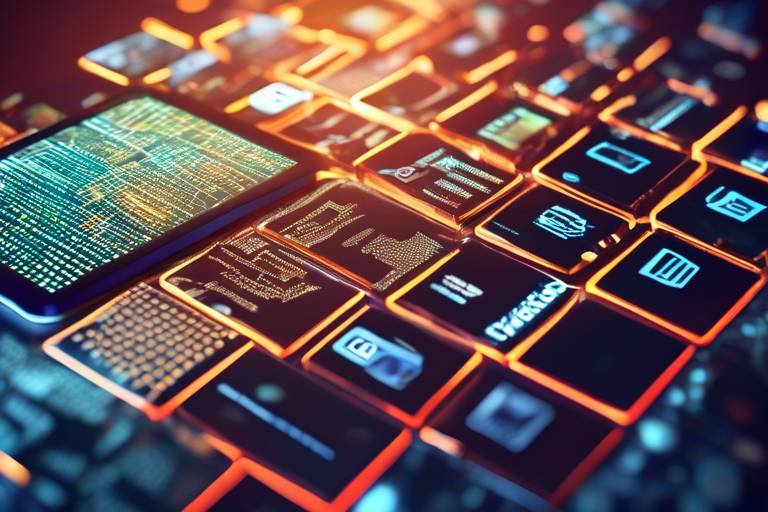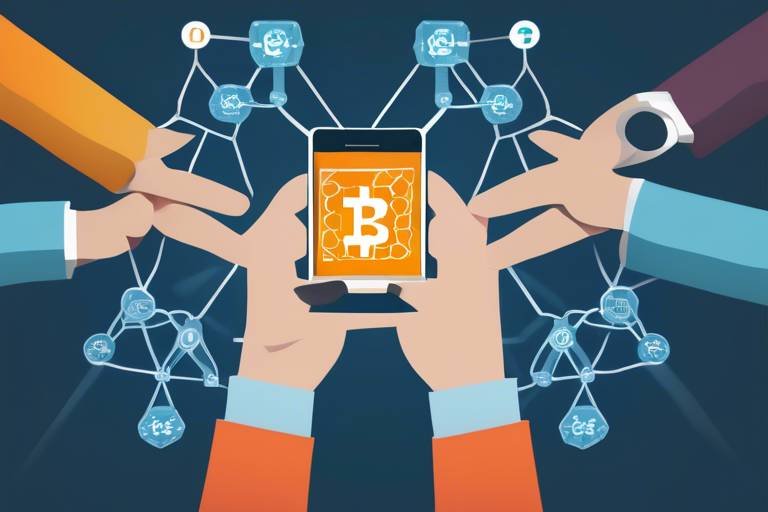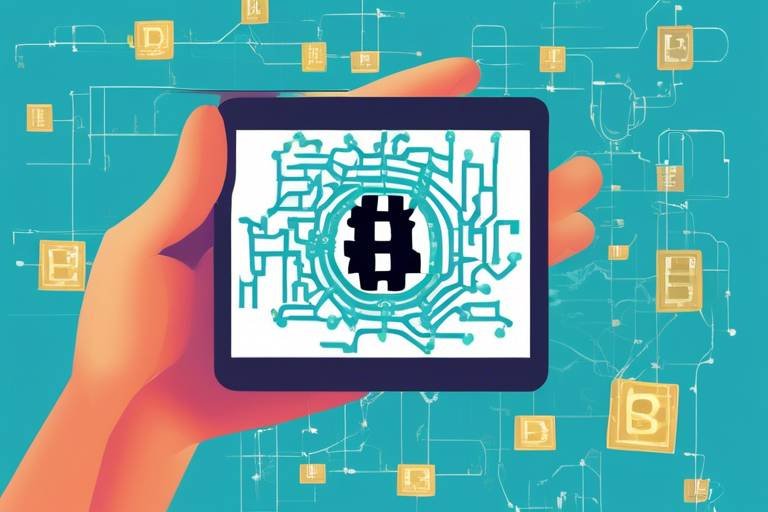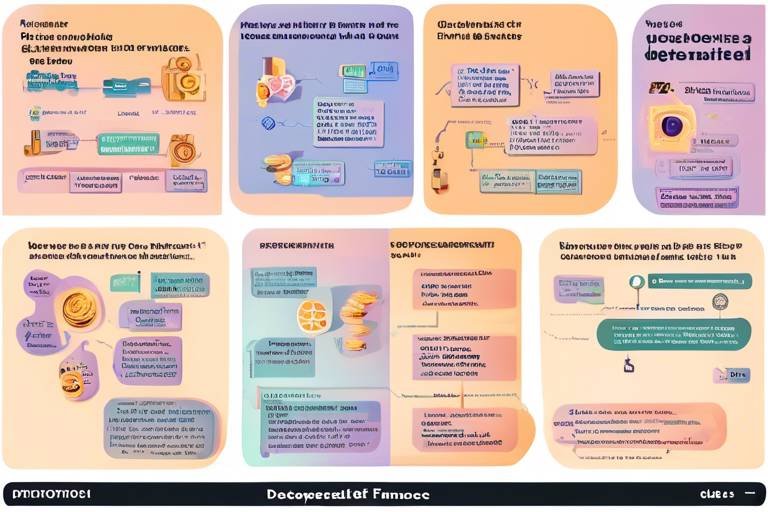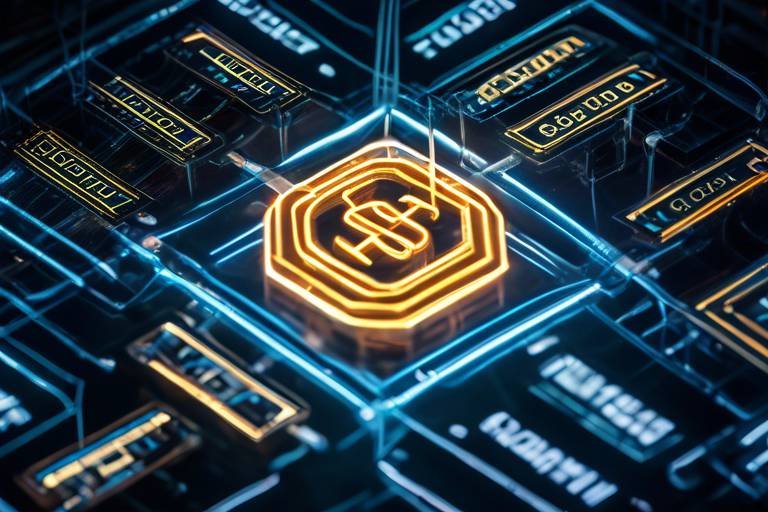The Role of Blockchain in Securing Online Education
In today's digital age, the landscape of education is rapidly evolving, and with it comes a myriad of challenges, especially concerning security and integrity. As we increasingly rely on online platforms for learning, the need for robust security measures has never been more critical. Enter blockchain technology, a revolutionary advancement that promises to transform the way we secure online education. Imagine a world where your academic credentials are not just stored in a centralized database, but are instead safeguarded by an unbreakable chain of cryptographic blocks. This article delves into how blockchain enhances the security and integrity of online education, addressing vital concerns such as data privacy, credential verification, and the overall trustworthiness of digital learning environments.
To appreciate the role of blockchain in online education, we must first grasp its fundamental principles. At its core, blockchain is a decentralized system that operates through a network of computers, known as nodes, which collectively maintain a public ledger. This ledger records transactions in a way that is transparent, secure, and immutable. Think of it as a digital notebook that everyone can see but no one can alter without consensus. The decentralization of data means that no single entity has control, which significantly enhances transparency and security. In the context of education, this means that student records, credentials, and personal information can be stored and managed in a way that is far less vulnerable to hacking or unauthorized access.
One of the most pressing concerns in online education is the protection of student information. With countless data breaches occurring every year, students and educational institutions alike are seeking solutions to safeguard sensitive information. Blockchain offers a robust answer through its advanced encryption and decentralized storage capabilities. By utilizing blockchain, educational platforms can ensure that personal data is not only encrypted but also distributed across a network of nodes, making unauthorized access nearly impossible. This innovative approach to data privacy not only protects students but also builds trust in online educational systems.
Another groundbreaking feature of blockchain technology is its ability to facilitate decentralized identity verification. This allows students to maintain control over their personal data while ensuring secure access to educational resources. Imagine being able to prove your identity and credentials without having to share every piece of personal information. This is the essence of decentralized identity management. By enabling students to own their data, blockchain reduces the risk of identity theft and fraud in online education.
Self-sovereign identity (SSI) is a game-changer for learners. It empowers individuals by giving them ownership of their credentials, which can be easily shared with employers or educational institutions without the need for intermediaries. This not only streamlines the verification process but also minimizes the chances of identity theft and fraud. With SSI, students can confidently navigate their educational journeys, knowing that their data is secure and under their control.
Despite the numerous advantages of decentralized identity systems, there are challenges to consider. Implementing these systems requires overcoming technological barriers and fostering widespread adoption among educational institutions. Many institutions may be hesitant to transition from traditional systems to blockchain-based solutions due to a lack of understanding or resources. However, the long-term benefits of adopting blockchain for identity management far outweigh these initial hurdles.
When it comes to verifying academic credentials, blockchain technology streamlines the process significantly. Traditional methods of credential verification can be tedious and prone to errors. With blockchain, qualifications are recorded on an immutable ledger, making them easily accessible to employers and institutions. This not only saves time but also ensures that the qualifications presented are authentic and verifiable. Imagine applying for a job and having your credentials instantly verified without the need for cumbersome paperwork. This is the future that blockchain brings to online education.
Academic fraud, such as diploma mills and falsified transcripts, poses a serious threat to the integrity of education. By leveraging blockchain's immutable ledger, educational institutions can significantly reduce instances of such fraud. Each record on the blockchain is time-stamped and cannot be altered, creating a transparent and trustworthy environment. This level of security not only protects students but also enhances the reputation of educational institutions.
Several educational institutions have successfully integrated blockchain technology into their systems, showcasing its potential. For instance, the University of Nicosia in Cyprus was one of the first to offer a degree program on the blockchain, allowing students to receive verifiable diplomas. Such real-world examples highlight best practices and outcomes, paving the way for broader adoption.
As we look ahead, the future of blockchain in education appears promising. Emerging trends and innovations, such as the integration of artificial intelligence and machine learning with blockchain, could further enhance the security and effectiveness of online education. The potential for creating personalized learning experiences while maintaining data integrity is an exciting frontier that educators and technologists are eager to explore.
- What is blockchain technology? Blockchain is a decentralized digital ledger that records transactions across multiple computers in a way that the registered information cannot be altered retroactively.
- How does blockchain enhance data privacy in education? Blockchain encrypts student data and stores it in a decentralized manner, making it less vulnerable to breaches.
- What are the benefits of self-sovereign identity? It allows individuals to control their personal data and credentials, reducing the risk of identity theft and fraud.
- Can blockchain help combat academic fraud? Yes, by providing an immutable record of credentials, blockchain makes it significantly harder to falsify academic records.

Understanding Blockchain Technology
When we hear the term blockchain, many of us instantly think of cryptocurrencies like Bitcoin. However, blockchain technology extends far beyond the realm of digital currencies. At its core, blockchain is a decentralized digital ledger that records transactions across many computers in such a way that the registered transactions cannot be altered retroactively. This feature ensures a high level of security and transparency, making it an appealing option for various applications, including online education.
So, how does blockchain work? Imagine a chain of blocks, where each block contains a list of transactions. When a new transaction occurs, it is added to a block. Once the block is filled, it is sealed with a unique cryptographic hash and linked to the previous block, creating a secure chain. This process makes it nearly impossible for anyone to alter the information without altering all subsequent blocks, which would require consensus from the network. This is what we call the immutability of blockchain.
One of the fundamental principles of blockchain is its decentralization. Unlike traditional databases that are controlled by a single entity, blockchain operates on a network of computers, or nodes, where each participant has access to the entire database. This decentralization ensures that no single entity has control over the entire system, promoting trust among users. In the context of online education, this means that students, educators, and institutions can interact without the fear of data manipulation or unauthorized access.
Furthermore, blockchain employs encryption to secure data. Each transaction is encrypted and linked to the previous one, forming a secure chain that is resistant to tampering. This level of security is particularly important in online education, where sensitive student information, such as grades and personal data, is often at risk. By utilizing blockchain, educational institutions can ensure that student data remains confidential and protected from cyber threats.
To illustrate the advantages of blockchain in online education, consider the following table:
| Feature | Traditional Systems | Blockchain Systems |
|---|---|---|
| Data Control | Centralized | Decentralized |
| Data Security | Vulnerable to hacks | Highly secure due to encryption |
| Transparency | Limited | Fully transparent and traceable |
| Data Integrity | Can be altered | Immutable and tamper-proof |
In summary, blockchain technology offers a revolutionary approach to securing online education. Its decentralized nature, combined with strong encryption and transparency, fosters a trustworthy environment for students and educators alike. As we continue to explore the implications of blockchain in education, it’s clear that this technology holds the potential to transform how we manage and protect educational data.

Enhancing Data Privacy
In today's digital age, where information is constantly exchanged and stored online, data privacy has become a crucial concern, especially in the realm of online education. With students' personal details, academic records, and sensitive information being shared across various platforms, the risk of data breaches and unauthorized access looms large. This is where blockchain technology steps in as a game changer, offering innovative solutions to enhance data privacy and protect student information.
Blockchain operates on the principle of decentralization, meaning that instead of being stored in a single location, data is distributed across a network of computers. This not only increases security but also makes it significantly harder for malicious actors to compromise the system. Each piece of information is encrypted and linked to the previous one, creating a secure and immutable ledger that is nearly impossible to alter. This feature is particularly beneficial for online education platforms, where maintaining the integrity of student data is paramount.
One of the standout features of blockchain technology is its ability to facilitate decentralized identity management. This means that students can have control over their personal data, deciding what to share and with whom. Rather than educational institutions or third-party platforms holding sensitive information, students can maintain ownership of their credentials. This self-sovereignty not only enhances privacy but also empowers learners, allowing them to navigate the educational landscape with confidence.
Imagine a world where you, as a student, hold the keys to your own academic identity. With decentralized identity management, this vision is becoming a reality. Using blockchain, students can create a digital identity that is secure, verifiable, and entirely under their control. This means that when applying for jobs or further studies, they can easily share their credentials without the risk of their data being misused or compromised.
Self-sovereign identity is a concept that is gaining traction in the online education sector. By allowing students to own their credentials, the risk of identity theft and fraud is significantly reduced. Students can share their verified achievements with potential employers or academic institutions without having to rely on intermediaries that may not prioritize data security. This not only fosters trust but also streamlines the verification process, making it easier for all parties involved.
While the benefits of decentralized identity management are clear, it's important to acknowledge the challenges that come with implementing such systems. Technological barriers, such as the need for robust infrastructure and user-friendly interfaces, can hinder widespread adoption. Furthermore, educational institutions must be willing to embrace this change and invest in the necessary training and resources. The transition to a blockchain-based identity management system requires a cultural shift, which can be daunting for many organizations.
In conclusion, blockchain technology holds immense potential for enhancing data privacy in online education. By providing students with control over their personal information and ensuring secure storage through decentralization, it creates a safer learning environment. However, for this potential to be fully realized, collaboration between technology providers and educational institutions is essential. Only then can we build a future where data privacy is not just an afterthought, but a foundational element of online education.
- What is blockchain technology? Blockchain is a decentralized digital ledger that records transactions across multiple computers in a way that ensures security and transparency.
- How does blockchain enhance data privacy? By decentralizing data storage and encrypting information, blockchain minimizes the risk of unauthorized access and data breaches.
- What is decentralized identity management? It allows individuals to control their personal data and credentials, reducing reliance on third-party services for verification.
- What challenges exist in implementing blockchain in education? Technological barriers, the need for institutional buy-in, and the requirement for user-friendly systems are significant challenges.

Decentralized Identity Management
In the ever-evolving landscape of online education, emerges as a game-changer. Imagine a world where students have complete control over their personal information, deciding what to share and with whom. This is made possible by blockchain technology, which allows for the creation of digital identities that are secure, private, and under the user's control. With traditional systems, educational institutions often hold the keys to students' data, leaving them vulnerable to breaches and unauthorized access. However, with blockchain, students can maintain their privacy while still accessing essential educational resources.
At its core, decentralized identity management leverages blockchain's unique features—transparency, immutability, and security. Each student can create a digital identity that is cryptographically secured and linked to their academic achievements. This identity is not stored in a central database but rather distributed across the blockchain network, making it nearly impossible for hackers to manipulate or steal. By employing this system, students can confidently share their credentials with potential employers or educational institutions without the fear of their data being compromised.
One of the most significant advantages of decentralized identity management is the concept of self-sovereign identity. This empowers learners to own their credentials, essentially putting them in the driver’s seat of their educational journey. For instance, when a student completes a course, they receive a digital certificate that is securely linked to their blockchain identity. This not only verifies their achievement but also allows them to present it to employers seamlessly. Think of it as having a digital badge that you can wear proudly, showcasing your skills and accomplishments without relying on third parties.
However, transitioning to a decentralized identity management system is not without its challenges. Educational institutions must overcome several hurdles, including technological barriers and the need for widespread adoption. The integration of blockchain technology requires significant investment and training, which can be daunting for many institutions. Moreover, there is a need for a standardized approach to ensure that all parties involved can communicate effectively. This is where collaboration among educational institutions, technology providers, and policymakers becomes crucial.
In summary, decentralized identity management represents a revolutionary shift in how students interact with educational platforms. By granting students control over their personal data, we not only enhance data privacy but also foster a more trustworthy and secure online learning environment. As we continue to explore the potential of blockchain in education, it’s essential to address the challenges head-on, paving the way for a future where learners can thrive without compromising their privacy.
- What is decentralized identity management?
Decentralized identity management is a system that allows individuals to control their personal data using blockchain technology, providing secure access to educational resources. - How does blockchain enhance data privacy?
Blockchain encrypts and decentralizes student information, making it more secure and less vulnerable to breaches. - What are the benefits of self-sovereign identity?
Self-sovereign identity gives learners ownership of their credentials, reducing the risk of identity theft and fraud. - What challenges does decentralized identity management face?
Challenges include technological barriers, the need for widespread adoption, and the establishment of standardized protocols.

Benefits of Self-Sovereign Identity
Self-sovereign identity (SSI) is a revolutionary concept that places the power of personal data back into the hands of the individual, particularly in the realm of online education. Imagine a world where students can manage their own credentials, choosing when and with whom to share their information. This is not just a dream; it's becoming a reality thanks to blockchain technology. By leveraging SSI, learners can enjoy several significant benefits that enhance their educational experience and security.
One of the most notable advantages of SSI is the enhanced control over personal data. Students no longer need to rely on educational institutions to manage their credentials, which often results in a lack of transparency and potential misuse of their information. With SSI, individuals can create digital wallets that store their academic achievements securely. This means they can present their qualifications to potential employers or other institutions without the fear of their data being compromised or misused.
Furthermore, SSI reduces the risk of identity theft and fraud. In a traditional educational setup, personal information is often stored in centralized databases, making it a prime target for hackers. However, with blockchain's decentralized nature, even if one node is compromised, the entire system remains secure. This decentralized approach not only protects student information but also builds a foundation of trust in the educational system.
Another key benefit is the streamlined verification process. Employers and educational institutions can easily verify the authenticity of a student’s credentials without the lengthy back-and-forth communication that usually occurs. This not only saves time but also fosters a more efficient hiring process, allowing students to showcase their skills and qualifications more effectively.
Moreover, SSI promotes lifelong learning. As students continue their education, they can add new credentials to their digital wallets, creating a comprehensive profile of their skills and achievements. This adaptability is crucial in today's fast-paced job market, where continuous learning is essential. By having a self-sovereign identity, learners can seamlessly transition from one educational opportunity to another, carrying their credentials with them wherever they go.
In summary, the benefits of self-sovereign identity in online education are profound. From granting students control over their personal data to enhancing security and streamlining credential verification, SSI is set to transform the educational landscape. As more institutions recognize the importance of this technology, we can expect a shift toward more secure and efficient online learning environments.

Challenges in Implementation
Implementing blockchain technology in online education is not without its hurdles. While the benefits are significant, the road to widespread adoption is paved with challenges that must be navigated carefully. One of the primary obstacles is the technological barrier. Many educational institutions are still grappling with outdated systems that are not equipped to integrate with blockchain solutions. This can lead to a disconnect between the innovative potential of blockchain and the reality of existing infrastructures.
Furthermore, there is a lack of awareness and understanding of blockchain among educators and administrators. Many may be hesitant to adopt a technology they do not fully comprehend, fearing the unknown or potential disruptions to established processes. This skepticism can stifle innovation and prevent institutions from exploring the full range of benefits that blockchain can offer.
Another significant challenge is the need for widespread adoption across various educational institutions. For blockchain to be effective in credential verification and identity management, it requires a network of participants who are willing to collaborate and share data securely. This raises questions about interoperability—how different systems can work together seamlessly. If institutions do not adopt compatible systems, the effectiveness of blockchain in education could be severely limited.
Moreover, there are regulatory concerns that need to be addressed. Governments and educational bodies may impose regulations that complicate the implementation of blockchain solutions. Institutions must navigate these legal landscapes to ensure compliance while trying to innovate. This often results in a slow-moving process that can frustrate stakeholders eager to see results.
Lastly, there's the issue of cost. Developing and implementing blockchain solutions can require significant investment. Smaller institutions, in particular, may struggle to allocate the necessary funds for such transformative technology. This financial barrier can lead to an uneven playing field where only larger, well-funded institutions can afford to adopt blockchain, leaving others behind.
In summary, while the potential of blockchain in online education is immense, overcoming these challenges is crucial for its successful implementation. Addressing technological barriers, fostering awareness, ensuring interoperability, navigating regulations, and managing costs will be key to unlocking the full benefits of blockchain technology in educational settings.
- What is blockchain technology? Blockchain is a decentralized digital ledger that records transactions across many computers in a way that the registered transactions cannot be altered retroactively.
- How does blockchain enhance data privacy? Blockchain uses encryption and decentralized storage to protect student information, ensuring that only authorized users can access sensitive data.
- What are the benefits of self-sovereign identity? Self-sovereign identity allows learners to own and control their credentials, reducing the risk of identity theft and enhancing privacy.
- What challenges does blockchain face in education? Key challenges include technological barriers, lack of awareness, the need for widespread adoption, regulatory concerns, and financial costs.

Credential Verification
In the ever-evolving landscape of online education, the need for reliable has never been more critical. Traditional methods of verifying academic qualifications can be cumbersome, often involving lengthy processes that not only waste time but also leave room for errors and fraud. Enter blockchain technology, which brings a revolutionary approach to this challenge. By utilizing a decentralized ledger, blockchain ensures that all academic credentials are securely recorded and easily accessible, making it a game-changer for both students and educational institutions.
Imagine a world where a simple scan of a QR code can provide potential employers with instant access to a candidate's verified educational history. This is not just a fantasy; it's a reality made possible by blockchain. Each credential—whether it be a degree, diploma, or certification—is stored as a unique digital entry on the blockchain. This immutability ensures that once a record is created, it cannot be altered or tampered with, thereby safeguarding the integrity of the information.
Moreover, the process of becomes significantly streamlined. Instead of relying on third-party verification services, employers can directly access the blockchain to confirm the authenticity of a candidate's qualifications. This not only speeds up the hiring process but also enhances trust between employers and job seekers. In fact, a recent study indicated that organizations utilizing blockchain for credential verification reported a 30% reduction in the time taken to hire new employees. Such efficiency is invaluable in today's fast-paced job market.
To further illustrate the impact of blockchain on credential verification, let’s take a look at a few key benefits:
- Enhanced Security: With blockchain's encryption methods, sensitive data related to educational qualifications is kept secure from unauthorized access.
- Cost-Effectiveness: Reducing reliance on third-party verification services can lead to significant cost savings for educational institutions.
- Global Accessibility: Blockchain's decentralized nature allows for easy access to credentials from anywhere in the world, breaking down geographical barriers.
However, like any technology, the implementation of blockchain for credential verification is not without its challenges. Institutions must navigate the complexities of integrating this technology into their existing systems. Additionally, there is a need for widespread acceptance and understanding among employers regarding how blockchain works and its benefits. Educational institutions must also invest in training staff and educating students about the new systems in place.
In conclusion, the integration of blockchain technology into credential verification processes offers a promising solution to the issues of authenticity and trust in online education. As we move forward, it will be essential for educational institutions to embrace this innovation to ensure that their graduates stand out in an increasingly competitive job market. The future of credential verification is not just about keeping up with technology; it's about leveraging it to create a more transparent and trustworthy educational environment.
Q1: How does blockchain improve the verification of credentials?
A1: Blockchain provides a secure, immutable record of credentials that can be easily accessed and verified by employers, reducing the risk of fraud and streamlining the hiring process.
Q2: Are there any downsides to using blockchain for credential verification?
A2: While blockchain offers numerous benefits, challenges such as technological integration, costs of implementation, and the need for widespread understanding among users can pose hurdles.
Q3: Can blockchain be used for all types of educational credentials?
A3: Yes, blockchain can be utilized for various types of credentials, including degrees, diplomas, certificates, and even micro-credentials, making it a versatile solution.

Combatting Academic Fraud
In the rapidly evolving landscape of online education, academic fraud has become a pressing concern. With the rise of diploma mills and the ease of manipulating academic records, educational institutions are under constant threat. However, the introduction of blockchain technology has emerged as a powerful ally in the fight against these fraudulent practices. By leveraging the unique characteristics of blockchain, such as its immutable ledger and decentralized nature, institutions can ensure that academic credentials are not only authentic but also easily verifiable.
Imagine a world where every degree, certificate, or transcript is securely stored on a blockchain. This means that once a credential is issued, it cannot be altered or erased. This level of security is akin to having a digital vault that protects your most valuable assets. With blockchain, educational institutions can create a permanent record of all academic achievements, making it nearly impossible for fraudsters to create fake diplomas or transcripts. This not only protects the integrity of the institution but also restores trust in the educational system.
Moreover, the decentralized nature of blockchain means that there is no single point of failure. Unlike traditional databases that can be hacked or manipulated, a blockchain is distributed across multiple nodes, making it incredibly resistant to tampering. Each transaction or record added to the blockchain is cryptographically secured, ensuring that any attempt to alter the data would be immediately evident. This transparency serves as a deterrent to potential fraudsters, knowing that their attempts to forge documents would be futile.
To further illustrate the impact of blockchain in combatting academic fraud, let's take a look at some real-world implementations:
| Institution | Implementation | Outcome |
|---|---|---|
| MIT | Issuing digital diplomas on the blockchain | Increased trust and reduced instances of diploma fraud |
| University of Nicosia | Blockchain-based credential verification system | Streamlined verification process for employers |
| Open University | Blockchain for storing learner records | Enhanced security and privacy for student data |
These case studies highlight the potential of blockchain to not only combat academic fraud but also to revolutionize the way educational institutions operate. By adopting blockchain, schools and universities can create a more secure and trustworthy environment for their students. This is especially crucial in an age where online education is becoming more prevalent, and the demand for verified credentials is higher than ever.
However, it is essential to recognize that while blockchain technology offers a robust solution, it is not a silver bullet. The successful implementation of blockchain in education requires collaboration among institutions, technology providers, and regulatory bodies. There needs to be a collective effort to establish standards and best practices for using blockchain in credentialing and verification processes.
As we look to the future, the integration of blockchain in online education will likely continue to grow. With ongoing advancements in technology and increasing awareness of the benefits of blockchain, we can expect to see more educational institutions adopting this innovative approach to combat academic fraud and enhance the overall credibility of online learning.
- What is academic fraud? Academic fraud refers to the act of falsifying academic credentials, such as degrees or transcripts, often for personal gain.
- How does blockchain prevent academic fraud? Blockchain prevents academic fraud by creating an immutable and secure ledger of academic credentials that is easily verifiable.
- Are there any challenges to implementing blockchain in education? Yes, challenges include technological barriers, the need for widespread adoption, and establishing standards across institutions.
- Can blockchain be used for other purposes in education? Absolutely! Blockchain can also be used for secure storage of student data, decentralized identity management, and enhancing data privacy.

Case Studies of Successful Implementation
In the ever-evolving landscape of online education, several institutions have taken the plunge into the world of blockchain technology, showcasing its potential to enhance security and integrity. One standout example is MIT Media Lab, which has pioneered the use of blockchain for issuing digital diplomas. By utilizing a blockchain-based system, MIT allows graduates to share their credentials directly with employers and other institutions, eliminating the need for intermediaries and reducing the risk of fraud. This innovative approach not only streamlines the verification process but also empowers graduates to have full control over their academic records.
Another notable case is the University of Nicosia in Cyprus, which became the first university in the world to accept Bitcoin for tuition payments. In addition to this, they have implemented a blockchain-based system for managing student records. This system allows students to access their transcripts securely and share them with potential employers, all while ensuring the authenticity of the documents. The university's forward-thinking approach highlights how blockchain can simplify administrative processes while enhancing transparency.
The Open University in the UK has also made significant strides by experimenting with blockchain to track student achievements and learning outcomes. By creating a digital portfolio on the blockchain, students can showcase their skills and accomplishments in a manner that is both verifiable and tamper-proof. This initiative not only aids students in presenting their qualifications but also assists employers in validating the credentials of potential hires.
Moreover, the W3C Blockchain Community Group has been exploring the integration of blockchain in educational settings, focusing on how it can facilitate decentralized identity management. By creating standards for educational credentials on the blockchain, they aim to provide a framework that can be adopted by institutions worldwide. This collaborative effort underscores the importance of community-driven solutions in advancing blockchain technology in education.
As these case studies illustrate, the successful implementation of blockchain technology in online education is not merely theoretical; it is happening right now. The benefits are clear: enhanced security, streamlined processes, and improved trustworthiness of educational credentials. However, it's essential to recognize that these implementations are not without their challenges. Institutions must navigate technological barriers and foster widespread adoption among stakeholders to fully realize the potential of blockchain in education.
- What is blockchain technology? Blockchain is a decentralized digital ledger that records transactions across many computers in a way that ensures the recorded transactions cannot be altered retroactively.
- How does blockchain enhance data privacy in online education? Blockchain protects student information through encryption and decentralized storage, making it difficult for unauthorized parties to access sensitive data.
- Can blockchain prevent academic fraud? Yes, by creating an immutable ledger of academic credentials, blockchain significantly reduces the chances of fraud, such as diploma mills and falsified transcripts.
- What are self-sovereign identities? Self-sovereign identities empower individuals to control their personal data and credentials, reducing the risk of identity theft and fraud.

Future Trends in Blockchain Education
As we look ahead, the future of blockchain in education is not just promising; it's downright exciting! With the rapid advancement of technology, we can anticipate several trends that will shape how we learn and interact in digital classrooms. One of the most significant trends is the integration of artificial intelligence (AI) with blockchain. Imagine a system where AI analyzes student performance and suggests personalized learning paths, all while securely storing achievements on a blockchain. This synergy could revolutionize how educators tailor their teaching methods to meet individual needs.
Another trend to watch is the rise of micro-credentials. As the job market evolves, employers are increasingly looking for specific skills rather than traditional degrees. Blockchain can facilitate the issuance and verification of these micro-credentials, allowing learners to showcase their competencies in a verifiable way. This not only empowers students but also gives employers confidence in the qualifications of potential hires. With platforms emerging that focus on skill-based learning, the traditional education model may soon be supplemented—or even replaced—by this more agile approach.
Furthermore, we are likely to see a greater emphasis on interoperability among educational platforms. Currently, many online education systems operate in silos, making it challenging for students to transfer their credits or achievements across institutions. Blockchain technology can create a seamless ecosystem where educational records are easily accessible and transferable, fostering collaboration among institutions and enhancing the overall learning experience. Imagine a world where you can take a course from one university and have that credit recognized by another institution without any hassle!
Finally, the concept of decentralized autonomous organizations (DAOs) in education is gaining traction. DAOs allow stakeholders—students, educators, and institutions—to participate in decision-making processes regarding curriculum and policies. This democratization of education can lead to more relevant and engaging learning experiences, as curricula can be adapted based on collective feedback and needs. The potential for a more inclusive educational environment is immense.
In summary, the future of blockchain in education is bright and filled with possibilities. From AI-enhanced learning experiences to the rise of micro-credentials and decentralized governance, we are on the brink of a transformative era in online education. As educational institutions begin to adopt these innovations, we can expect a more secure, personalized, and efficient learning landscape that prepares students for the challenges of tomorrow.
- What is blockchain technology? Blockchain is a decentralized digital ledger that records transactions across many computers, ensuring that the record cannot be altered without the consensus of the network.
- How does blockchain enhance data privacy in education? By using encryption and decentralized storage, blockchain protects student information from unauthorized access, allowing learners to control their data.
- What are micro-credentials? Micro-credentials are short, focused qualifications that demonstrate specific skills or knowledge, often more relevant to the current job market than traditional degrees.
- Can blockchain prevent academic fraud? Yes, the immutable nature of blockchain makes it difficult to alter or forge academic records, thus significantly reducing instances of fraud.
- What role will AI play in the future of blockchain education? AI can analyze student data to create personalized learning experiences while securely storing and verifying achievements on the blockchain.
Frequently Asked Questions
- What is blockchain technology?
Blockchain technology is a decentralized digital ledger that records transactions across many computers. This ensures that the recorded transactions cannot be altered retroactively, enhancing security and transparency. In the context of online education, it helps protect student data and verifies credentials.
- How does blockchain enhance data privacy in online education?
Blockchain enhances data privacy by using encryption and decentralized storage. This means student information is not stored in a single location, making it less vulnerable to breaches. Each student has control over their personal data, ensuring that only authorized parties can access it.
- What is decentralized identity management?
Decentralized identity management allows students to have ownership of their digital identities. With blockchain, learners can manage their credentials and share them securely without relying on a central authority, reducing the risk of identity theft and fraud.
- What are the benefits of self-sovereign identity?
Self-sovereign identity empowers learners by giving them complete control over their credentials. This reduces the chances of identity theft and fraud, as students can verify their qualifications without needing to go through third parties.
- What challenges exist in implementing blockchain in education?
While blockchain offers numerous benefits, challenges such as technological barriers, costs, and the need for educational institutions to adopt the technology can hinder implementation. Additionally, there is a need for standardization and regulatory frameworks to ensure widespread acceptance.
- How does blockchain streamline credential verification?
Blockchain simplifies the credential verification process by providing a secure and easily accessible platform for storing qualifications. Employers and institutions can verify a candidate's credentials quickly and reliably, reducing the potential for fraud.
- How does blockchain combat academic fraud?
By utilizing an immutable ledger, blockchain can significantly decrease instances of academic fraud. This technology makes it nearly impossible to alter or falsify academic records, thus protecting the integrity of educational qualifications.
- Are there any real-world examples of blockchain in online education?
Yes, there are several case studies where blockchain has been successfully integrated into online education systems. These examples showcase best practices and highlight the positive outcomes of using blockchain technology for credential verification and data security.
- What are the future trends in blockchain for education?
Future trends in blockchain for education include increased adoption of decentralized identity systems, enhanced security measures, and the integration of smart contracts for automating processes. These innovations promise to further improve the security and effectiveness of online education.







